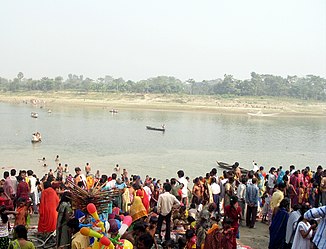Burhi Gandak
| Burhi Gandak | ||
|
Pilgrims at the Burhi Gandak near Muzaffarpur |
||
| Data | ||
| location | Bihar ( India ) | |
| River system | Ganges | |
| Drain over | Ganges → Bay of Bengal → Indian Ocean | |
| source | in the Someshwar Hills, 27 ° 21 ′ 50 ″ N , 84 ° 21 ′ 4 ″ E |
|
| Source height | approx. 300 m | |
| muzzle |
Ganges coordinates: 25 ° 20 ′ 4 " N , 86 ° 34 ′ 57" E 25 ° 20 ′ 4 " N , 86 ° 34 ′ 57" E
|
|
| length | 320 km | |
| Catchment area | 12,021 km² (including 9601 km² in India) | |
| Left tributaries | Pandai | |
| Right tributaries | Masan | |
| Big cities | Muzaffarpur | |
| Medium-sized cities | Narkatiaganj , Samastipur , Rosera , Khagaria | |
| Small towns | Chanpatia , Chakia | |
The approximately 320 km long Burhi Gandak ( Nepali : बुडी गण्डकी खोला ) is a northern tributary of the Ganges in the northern Indian state of Bihar . Its catchment area covers a total of approximately 12,000 km², the largest part of which is in India.
course
The Burhi Gandak rises in the Someshwar hills , a range of Siwaliks in the West Champaran district not far from the border with Nepal . The river initially flows mainly in a southerly direction through the lowlands of the Ganges plain and flows west past Narkatiaganj . North of the town of Lauria Nandangarh , the Masan meets the Burhi Gandak when coming from the west. This turns slowly to the southeast and meanders through the lowlands. The city of Chanpatia is on the south bank. Shortly afterwards, the pandai meets the Burhi Gandak on the left. The city of Motihari is about 8 km south of the river. Muzaffarpur , Samastipur , Rosera and Khagaria are cities on the lower reaches of the river. This finally flows into the east flowing Ganges opposite the city of Munger .
history

The upper reaches of the river ( called Sikrchana here ) flows through an ancient area shaped by Buddhism . In the town of Lauria Nandangarh , several stupas were discovered by Alexander Cunningham in the 1860s ; Further excavations by other researchers followed, but the complex was not finally examined until the 1930s. Based on the size of the earthfill, it was found that the large stupa must once have been one of the largest in all of India. Even more important than the stupas that no longer exist is a polished sandstone column with inscriptions and a lion capital from the time of Emperor Ashoka, about 2 km away .
Web links
- Burhi Gandak - Map + Info (English)
